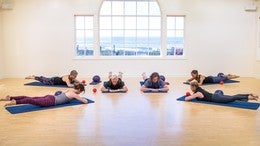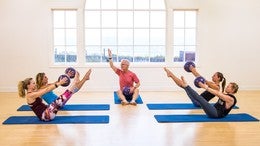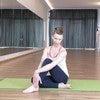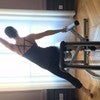Tutorial #3372
Elongation of the Spine
Description
About This Video
Transcript
Read Full Transcript
Hi, I'm Michael. And I'm Ton and welcome to Pilates Anytime. Today we're going to talk about elongation of the spine and with that we are going to incorporate some of the concepts of spiral dynamic which we talked about it in another workout before, a method from Switzerland. And you probably are asking, "Elongation, what is it?" It's the act of lengthening your spine and it's probably the most important action of your spine because without it you cannot do other movements like flexion, extension, lateral flexion, rotations, they're not possible. And like Ton said, we're using the concept of spiral dynamic and it's basically in the spine, they call it a coordination of the spine which includes the head and the pelvis at the top poles, the head and the pelvis being the poles and the body in between is the spine.
Basically we include the head and the pelvis because the head and the pelvis affect the alignment of the spine. Often times with Pilates teachers some teachers only look at the spine as the spine from here down to the tailbone and they don't really include all of the pelvis and all of the head which hopefully during this short tutorial you'll learn why it's important with the head and the pelvis. So when Michael talked about the coordination unit of the spine he talked about the two poles and, can you stand up? When we look at the two poles, we look at the head and the pelvis, and when you look at it from the transverse axis, the axis that goes from right ear to left ear, you can see the axis runs roughly by the ears. So when the axis runs through here, most of the bone, the heavy bone, is actually in front of that axis which gives the head the sensation of impulse to go slightly in that direction.
So it lengthens the neck, right? So when we look at the bottom pole, the pelvis, the axis goes around the acetabulum. When we look at it from that point of view, the heavier bones are actually in the back of the axis which then has that tendency of dropping down from the back, if that makes sense. Now these are very small movements, it's actually not even a movement when you're standing, it's more of an impulse of movement. So when that happens, it creates length in the spine.
So from a model point of view, I can hold that if you wanna stand, yeah. So this is Michael, this is Michael's head, this is Michael's hips. Mini Michael. (laughing) Even smaller. I've gotten even shorter.
(laughing) So if we roughly look at this, so the impulse of the head is to go this way and the impulse of the pelvis to go this way, you can see how the body in between, the spine and the fascia and the muscles, get a pretension of before movement. And that is a preparation for movement or also a great way to absorb and distribute forces that come for example from the ground up when you walk. So if you don't have that pretension, you get that blocking, that locking feeling in your back. So, from here we are going to do some exercises specifically to find that length and the first exercise we're going to do is what we call a towel lengthening exercise. So for our towel exercise one needs a towel.
So when you place the towel down, you want to fold it up roughly like an accordion, if you wanna call it that way. And then with enough towel left for the client to sit in front of the accordion. So, the client is gonna sit down so that the fold up part is roughly in their lumbar spine. Then you're going to get a little comfortable with your client and you're going to grab as close as possible. The client is not going to do anything, their pelvis is going to be relaxed.
And as I slowly pull the towel from underneath him, he is going to get lengthening, he's going to get sort of like a traction feeling of that spine. And he feels that elongation of the spine. So what we want them to feel is to get the experience of what it feels like to have that long spine. For someone who lives in this position, this is long for them. So we have to show them and give the experience of what that feels like.
So then, we're going to the figure eight. We take a spiky ball or you may take a softer ball if that works better and you're gonna place it on the sacrum. So, you wanna place it down? For every person it's gonna be slightly different but roughly in that neighborhood. So we talked about the transverse axis before to find that elongation.
So if we think of the transverse axis again, he's going to move from the front of the spine. So what he's going to do is pull the pubic bone up towards him and then he's going to release it and the sitz bones are going to drop down. So he's going to have to adapt if it doesn't work on the way down. If he cannot lower the hips or the pelvis down, the sitz bones down, then the ball is most likely not in the right position. You want to do that a couple of times, you don't wanna use the glutes too much.
So to get that length feeling. Now when he stops, we're going to move through the sagittal axis. The sagittal axis is the axis going straight through your body. So from here, if we're going to move around that, it's like a plate rotating on top of a table. So the right sitz bone goes to the left big toe and the left sitz bone goes to the right big toe.
So the plate is on the table and it rotates around itself as it goes. So that's the second axis. Then we have the third axis which is the longitudinal axis which goes right up and down through your body. So if you think of that as the axis, the motion would be up and down. So if you think of the ASI as your hip bones as a seesaw, the right side comes down to the floor and then the left side comes down to the floor.
So when you put it all together, your pelvis makes a backwards pedaling motion. So it goes down, it goes forward, and up. Down, forward, and up. Down, forward, and up. And reach.
So, if he keeps on going with that, he gets that same elongation feeling that we had when we did it with a towel, only that was passive and this is active. So now they have to work for that length. So at the end he's gonna roll up, we're gonna take the ball away, he's slowly going to roll down. Hopefully all the fascia and the ligaments have relaxed and they get more of a relaxation of that same kind of traction. So thinking back to the coordination unit of the spine, we have two poles.
This was one pole, that's the other pole. So we're going to do the same thing onto the other pole. We're going to place the ball sort of like on the occipital ridge there. Now, that can be very tender so some people you might wanna change the ball, you might wanna move the ball a little bit away from that force. We can move through all the same axes.
So the first axis was the ear, the transverse axis. So he can have the head going slightly down and slightly up, it's like a nodding motion. We wanna make it very small. So we want, if you think of the first vertebrae where the skull is resting on top of it, we want the skull to move on top of that atlas, right? Now, we can go this way, we can go through our sagittal axis which means that the ear goes slightly up and up.
So the axis is now right, let's say roughly his nose and he spins around that. Then the other axis is still the longitudinal axis, the one that goes right through the head. And that would be the axis of saying no, going from one end to the other. This kind of a rotation actually happens in the cervical spine, C1 and C2, when it rotates around that den of C2. When you put that together, it also makes a pedaling motion.
This time we create the pedaling motion going forward. The easiest way to do that is to place your hands around your ears and guide your own head into that pedaling motion, going forward in this direction. So the pelvis, the pedaling went backwards. The head, the pedaling is going forwards. So when he gracefully gets off that one, he finds that relaxation.
So the reason why we want the two pedaling motions to go the other way is that that is the functional motion of the pelvis and the head. That is the actual figure eight or pedaling motion your spine does, the pelvis and the head does when you're walking. So, if you wanna see that with our high end model here. So, you wanna be the pelvis? Yep, I'll be the pelvis.
We have the head here on the top, we have the pelvis here at the bottom. So we have discovered that the pedaling backwards is from the pelvis and if I pedal forward, what happens is it has a constant free tension. So the body has created a mechanism that always keeps that active length, that active pretension to distribute all the forces for everything we do in our spine. So it's quite genius of how it has put it together. I would agree.
I'm glad you do. (laughing) So an example, I think, of how it works out with the Pilates system would be the foot work.
So the head piece goes up which gives that impulse around the transverse axis to create that length. With the feet up, it allows the pelvis to drop down and create that same kind of impulse of lengthening which then creates that pretension along the spine before you even start to distribute the force and to start to create pretension for movement. So for the pelvis, to create that pretension, the rectus abdominis are the most important. So the rectus abdominis that are connected in the front directly to the pubis create that pull up feeling that allows the pelvis to go into that elongation of the spine before you start. And often times in Pilates what happens is we train the top, like if you think of the roll up or you think of the hundred, we're constantly, if Ton's here, he's training the top but he's not getting the rectus abdominis and one of the easiest ways to get that is actually the short spine prep which some of you are probably familiar.
You wanna start with your feet even with your hips and what I would call like an open diamond shape. You're gonna grab onto the straps and in a perfect world, nothing here moves. The carriage doesn't move, the straps don't move. Now, what he's gonna do using the rectus abdominis is he's gonna just think of curling in so it lifts in and it lowers down. What most people do is to get that curl is they push down in the back and then lift up.
But you can see that that's wrong, this is right. If he thinks of lengthening, that elongation we talked about and it curls up and in. So it's not a press down with the spine then just lift up, it's a curl in to create that elongation. You do that pretty well, I'm impressed. Well, thank you so much.
So, another version of doing that is on the push through bar. So when you get to the push through bar and you bring the spring on the top and the client is gonna lie down with their knees over the bar. There you go. You wanna probably come down a little more. When you have the fourth part, the fourth bar here, you could put your feet against that bar and it can help you to get up a little easier and get that back line through the heels to be activated.
But for right now we'll do it this way. And he does the same thing that we did over there. So he's gonna pull up from the front to lift it up and then he can lower it back down. You can play with the rhythm, so you can play up of coming up faster and then have a slow control coming back down if that's what you decide to do in regards to the eccentric control of the rectus abdominis. Because like Michael said, the bottom part is the one that's really important for the elongation of the spine.
There we are. Then, the next exercise we would like to show is the roll back bar. So the roll back bar is quite similar to the roll up as far as like a spine connection. So when you do the roll down, we want that same lift that we just created to start to curl coming down. So he still has that same pulling up from that pubis bone to come down.
Now, on the way up, we want him to keep that and not to go too far into a tuck to roll up so that this stays long and the body goes towards it and not the bottom coming up towards the rib cage too far. So he gets that curling under feeling and if he does that front really well, he can keep his heels basically against the poles. So when the feet come away from the poles that is often a sign that they don't have that right connection down at the bottom of the rectus abdominis. And there we are for the roll down. But you can also take this position from standing up.
If we have the push down on the chair, if Ton's standing over here, it's the same thing but just imagine the back of the Cadillac is back behind him. The pelvis is still there, it's curling up, not sticking out. And he tries to keep that elongation as he goes down. Good. And presses it down, pulls it up more.
And basically what Ton talked about is the same thing here. And he's rolling up so it's just down and up and then he's gonna come all the way up. It's just different resistance, different body position, different angle, but he's still keeping it curled under under the lift and lower. So, I hope this helped in understanding the elongation of the spine. In a different kind of way.
Have fun. Have a good day.
Comments
You need to be a subscriber to post a comment.
Please Log In or Create an Account to start your free trial.
























